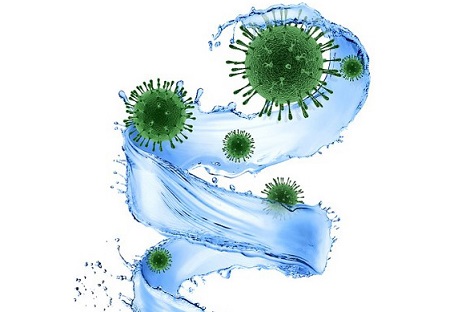Highly Pathogenic Avian Influenza H5N1 Viruses Can Also Spread Via Water-Borne Transmissions!
Nikhil Prasad Fact checked by:Thailand Medical News Team Apr 24, 2024 1 year, 7 months, 3 weeks, 14 hours, 19 minutes ago
H5N1 News: The emergence and spread of highly pathogenic avian influenza viruses pose significant challenges to public health and veterinary medicine. Among these, the H5N1 subtype has garnered particular attention due to its zoonotic potential and the devastating impact it can have on both avian and human populations. In recent years, research has shed light on the potential for water-borne transmission of H5N1 viruses, highlighting the complex interplay between wild birds, domestic poultry, and aquatic environments. This
H5N1 News report delves into a study conducted in Dongting Lake, China, which provides insights into the genetic diversity, transmission dynamics, and pathogenicity of H5N1 viruses, with a specific focus on water-borne transmissions.
 H5N1 Can Also Spread Via Water-Borne Transmissions
Historical Context of H5N1 Avian Influenza
H5N1 Can Also Spread Via Water-Borne Transmissions
Historical Context of H5N1 Avian Influenza
The history of H5N1 avian influenza dates back to its initial identification in China in 1996. Subsequent human infections were reported in Hong Kong in 1997, signaling the virus's ability to cross species barriers. Over the years, H5N1 has evolved into multiple phylogenetic lineages, including Clades 2.3.2 and 2.3.4, with sporadic cases of human infections recorded globally. While human-to-human transmission remains rare, the virus's pandemic potential looms large, necessitating continuous surveillance and research efforts.
Ecological Dynamics in Dongting Lake
Dongting Lake serves as a crucial ecological hotspot, particularly for migratory waterfowl traversing the East Asian flyway. The convergence of wild birds and domestic poultry in this region creates a dynamic interface where avian influenza viruses can potentially jump between species. The wetland's role as an overwintering area further amplifies the risk of viral dissemination, highlighting the need for targeted investigations into transmission pathways.
Study Design and Findings
The study conducted in Dongting Lake involved comprehensive surveillance efforts, including the collection of water samples from areas frequented by wild waterfowl and cloacal swabs from lakeside backyard poultry. Remarkably, the researchers isolated 10 H5N1 strains from water samples and 4 strains from backyard poultry, representing distinct clades such as 2.3.2, 2.3.4, and 7. Phylogenetic analysis unveiled a diverse genome constellation, with certain water isolates closely resembling those from lakeside poultry, hinting at potential transmission routes.
Genetic Characterization and Transmission Dynamics
Genomic analyses provided valuable insights into the genetic diversity and origin of H5N1 viruses in Dongting Lake. The presence of polybasic amino acid sequences indicative of high pathogenicity underscored the virulence potential of these strains. Phylogenetic reconstructions traced the evolutionary trajectories of different clades and highlighted genetic exchanges between poultry and wild bird populations. Notably, the study identified potential transmission events from lakes
ide poultry to wild waterfowl, emphasizing the interconnectedness of these ecological niches.
Pathogenicity Assessments
Pathogenicity experiments in specific-pathogen-free (SPF) chickens and mice shed light on the varying virulence profiles of H5N1 strains. While all selected viruses exhibited high pathogenicity in chickens, their effects in mice varied, reflecting the complex interplay between viral genetics and host susceptibility. Certain strains caused systemic infections in mice, underscoring the need for nuanced assessments of pathogenic potential across species barriers.
Implications for Public Health and Wildlife Management
The study's findings have significant implications for public health interventions and wildlife management strategies. The genetic similarities between water isolates and domestic poultry strains suggest ongoing viral circulation and potential spillback events. This underscores the importance of integrated surveillance programs encompassing both avian and environmental sampling. Furthermore, the role of water bodies as potential vectors necessitates targeted mitigation measures to curtail viral spread.
Future Directions and Research Imperatives
Moving forward, continued research in Dongting Lake and similar ecological hotspots is essential to monitor viral dynamics, identify emerging threats, and inform evidence-based interventions. Collaborative efforts involving multidisciplinary teams comprising virologists, ecologists, and public health experts are crucial for holistic understanding and effective management of avian influenza risks. Furthermore, leveraging advanced genomic tools and modeling techniques can enhance predictive capabilities and aid in early warning systems.
Conclusion
In conclusion, the study underscores the complex interplay between highly pathogenic avian influenza viruses, wild bird populations, domestic poultry, and aquatic environments. By elucidating genetic diversity, transmission dynamics, and pathogenicity profiles, researchers have contributed valuable insights into the potential for water-borne transmissions of H5N1 viruses. These findings underscore the importance of proactive surveillance, targeted interventions, and interdisciplinary collaborations in mitigating the risks posed by avian influenza to both animal and human health.
The study findings were published in the peer reviewed journal: Frontiers In Microbiology.
https://www.frontiersin.org/journals/microbiology/articles/10.3389/fmicb.2022.896469/full
For the latest
H5N1 News, keep on logging to Thailand Medical News.
